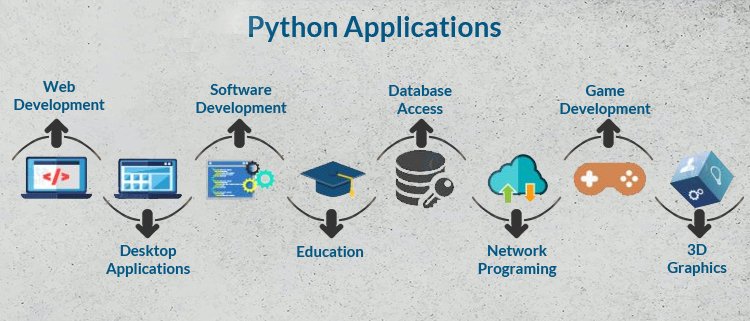Python applications span a wide range of domains, from web development and data science to machine learning and automation. Python is widely used in creating web applications with frameworks like Django and Flask. It finds extensive use in data science through libraries like NumPy, Pandas, and Matplotlib. Furthermore, Python is a popular choice for machine learning and AI applications, owing to its powerful libraries such as TensorFlow and Scikit-learn. Its versatility also extends to fields like desktop GUI applications, scientific computing, and automation, making it a top pick for developers across various industries.
Python’s in versatility as a general-purpose programming language renders it applicable across a wide spectrum of software development domains. As a prominent presence in various emerging fields, Python has secured its position as the fastest-growing programming language, capable of facilitating the development of diverse applications. Here, we highlight specific application domains where Python finds extensive use.

1) Web Applications:
Python application is instrumental in the development of web applications, offering libraries that efficiently manage internet protocols like HTML, XML, JSON, as well as email processing. Notably, the language supports several beneficial frameworks, including:
- Django and Pyramid framework (for robust applications)
- Flask and Bottle (for micro-framework applications)
- Plone and Django CMS (for advanced content management)
2) Desktop GUI Applications:
In this python application The GUI stands for the Graphical User Interface, which provides a smooth interaction to any application. Python provides a Tk GUI library to develop a user interface. Some popular GUI libraries are given below.
- Tkinter or Tk
- wxWidgetM
- Kivy (used for writing multitouch applications )
- PyQt or Pyside
How to install python in windows and mac
3) Console-based Application:
Python application is well-suited for the development of console-based applications, which execute from the command-line or shell. These applications rely on command inputs for execution and were notably prevalent in earlier generations of computing. Python’s prowess in this area is further bolstered by its renowned Read-Eval-Print Loop (REPL), making it an optimal choice for command-line applications.
The language offers a plethora of free libraries and modules that facilitate the construction of command-line apps. Essential I/O libraries handle the reading and writing processes, while built-in support enables effortless parsing of arguments and the creation of console help text. Additionally, advanced libraries empower the creation of independent console applications with sophisticated functionality.
4) Software Development:
Python application serves as a valuable asset in the software development process, operating as a support language for various functions such as control and management, testing, and more.
Some of the tools commonly used in the software development process with Python include:
- SCons for build control
- Buildbot and Apache Gump for automated continuous compilation and testing
- Round or Trac for bug tracking and project management.
5) Scientific and Numeric:
In this era of Artificial Intelligence, where machines mimic human tasks, Python stands out as the optimal language for AI and machine learning endeavors. Its rich collection of scientific and mathematical libraries streamlines the resolution of intricate calculations.
For the implementation of machine learning algorithms, Python offers a range of libraries catering to scientific and numerical tasks, including Numpy, Pandas, Scipy, Scikit-learn, and more. These libraries can be imported at the beginning of the code, enabling efficient handling of complex mathematical operations. Notably, some of the popular machine learning frameworks in Python are:
- SciPy
- Scikit-learn
- NumPy
- Pandas
- Matplotlib
6) Business Applications:
Business applications, such as E-commerce and ERP systems, differ from standard applications, necessitating extensive scalability and readability. Python, with its versatile features, caters to these specific requirements.
An exemplar of a comprehensive Python-based application is Odoo, offering a diverse array of business applications. Python’s Tryton platform serves as an instrumental tool for the development of various business applications.
Python Programming Language
7) Audio or Video-based Applications:
Python’s versatility extends to the development of multimedia applications, exemplified by the creation of tools such as TimPlayer and cplay. Several multimedia libraries further enhance Python’s capabilities in this domain, including:
- Gstreamer
- Pyglet
- QT Phonon
8) 3D CAD Applications:
Python’s capabilities extend to the development of 3D CAD (Computer-aided design) applications, facilitated by various functionalities, some of which are:
- Fandango (Popular)
- CAMVOX
- HeeksCNC
- AnyCAD
- RCAM
9) Enterprise Applications:
Enterprise Applications developed using Python cater to the specific needs and operations within an organization. Notable examples of such applications include OpenERP, Tryton, and Picalo.
10) Image Processing Application:
Python hosts a multitude of libraries dedicated to image processing, enabling users to manipulate images to suit their requirements. Some prominent libraries for image processing include:
- OpenCV
- Pillow
- SimpleITK
This topic has covered various types of applications where Python serves as a crucial tool in their development. In the next tutorial, we will delve deeper into additional concepts related to Python.

thank you